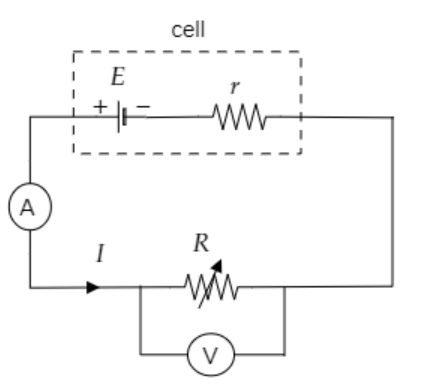
A voltmeter is connected in parallel with a variable resistance which is in series with an ammeter and a cell. For one value of $R$, meters read $0.3{\text{A}}$ and $0.9{\text{V}}$. For another value of $R$ the readings are $0.25{\text{A}}$ and $1{\text{V}}$. Find the internal resistance of the cell.
A) $0.5\Omega $
B) $2\Omega $
C) $1.2\Omega $
D) $1\Omega $
Answer
216.9k+ views
Hint: Here the variable resistance is connected in series with the cell having an internal resistance. Then the voltage across the variable resistance will be the difference between the emf of the cell and the potential drop across the internal resistance of the cell. Using the given meter readings for two different values of resistances, we can form two equations for the potential difference across the variable resistor.
Formula used:
The potential difference across a resistor is given by, $V = IR$ where $I$ is the current through the resistor and $R$ is the resistance of the resistor.
Complete step by step answer:
Step 1: Sketch a circuit diagram of the given arrangement.

Here the resistance of the variable resistor is denoted by $R$ and the internal resistance of the cell is $r$.
Let $E$ be the emf of the cell and let $I$ be the current through the circuit.
Also, let $V$ be the potential difference across the variable resistor.
Step 2: Express the potential drop across the variable resistor for the different meter readings.
The potential difference across the variable resistor can be expressed as $V = E - \left( {I \times r} \right)$
$ \Rightarrow E = V + \left( {I \times r} \right)$ ------ (1)
Substituting for $I = 0.3{\text{A}}$ and $V = 0.9{\text{V}}$ in equation (1) we get, $E = 0.9 + 0.3r$ ------- (2)
Substituting for $I = 0.25{\text{A}}$ and $V = 1{\text{V}}$ in equation (1) we get, $E = 1 + 0.25r$ ------- (3)
Step 3: Using equations (2) and (3) obtain the internal resistance of the cell.
We can equate the R.H.S of equations (2) and (3) to obtain the internal resistance of the cell.
i.e., $0.9 + 0.3r = 1 + 0.25r$
$ \Rightarrow r = \dfrac{{0.1}}{{0.05}} = 2\Omega $
Thus the internal resistance of the cell is $r = 2\Omega $ .
So the correct option is (B).
Note: Here the internal resistance of the cell and the variable resistor are essentially connected in series. In a series connection between two resistors, the current through each resistor will be the same. However, the potential drop across the internal resistance and the variable resistance are different. The term $I \times r$ in equation (1) is the potential drop across the internal resistance of the cell. Equation (1) can also be referred to as the voltage equation of the given circuit.
Formula used:
The potential difference across a resistor is given by, $V = IR$ where $I$ is the current through the resistor and $R$ is the resistance of the resistor.
Complete step by step answer:
Step 1: Sketch a circuit diagram of the given arrangement.

Here the resistance of the variable resistor is denoted by $R$ and the internal resistance of the cell is $r$.
Let $E$ be the emf of the cell and let $I$ be the current through the circuit.
Also, let $V$ be the potential difference across the variable resistor.
Step 2: Express the potential drop across the variable resistor for the different meter readings.
The potential difference across the variable resistor can be expressed as $V = E - \left( {I \times r} \right)$
$ \Rightarrow E = V + \left( {I \times r} \right)$ ------ (1)
Substituting for $I = 0.3{\text{A}}$ and $V = 0.9{\text{V}}$ in equation (1) we get, $E = 0.9 + 0.3r$ ------- (2)
Substituting for $I = 0.25{\text{A}}$ and $V = 1{\text{V}}$ in equation (1) we get, $E = 1 + 0.25r$ ------- (3)
Step 3: Using equations (2) and (3) obtain the internal resistance of the cell.
We can equate the R.H.S of equations (2) and (3) to obtain the internal resistance of the cell.
i.e., $0.9 + 0.3r = 1 + 0.25r$
$ \Rightarrow r = \dfrac{{0.1}}{{0.05}} = 2\Omega $
Thus the internal resistance of the cell is $r = 2\Omega $ .
So the correct option is (B).
Note: Here the internal resistance of the cell and the variable resistor are essentially connected in series. In a series connection between two resistors, the current through each resistor will be the same. However, the potential drop across the internal resistance and the variable resistance are different. The term $I \times r$ in equation (1) is the potential drop across the internal resistance of the cell. Equation (1) can also be referred to as the voltage equation of the given circuit.
Recently Updated Pages
Wheatstone Bridge Explained: Working, Formula & Uses

Young’s Double Slit Experiment Derivation Explained

JEE Atomic Structure and Chemical Bonding important Concepts and Tips

JEE Amino Acids and Peptides Important Concepts and Tips for Exam Preparation

Electricity and Magnetism Explained: Key Concepts & Applications

Chemical Properties of Hydrogen - Important Concepts for JEE Exam Preparation

Trending doubts
JEE Main 2026: Application Form Open, Exam Dates, Syllabus, Eligibility & Question Papers

Derivation of Equation of Trajectory Explained for Students

Hybridisation in Chemistry – Concept, Types & Applications

Understanding the Angle of Deviation in a Prism

Understanding Collisions: Types and Examples for Students

How to Convert a Galvanometer into an Ammeter or Voltmeter

Other Pages
JEE Advanced Marks vs Ranks 2025: Understanding Category-wise Qualifying Marks and Previous Year Cut-offs

Understanding Atomic Structure for Beginners

Ideal and Non-Ideal Solutions Explained for Class 12 Chemistry

Degree of Dissociation: Meaning, Formula, Calculation & Uses

Understanding Electromagnetic Waves and Their Importance

Understanding the Electric Field of a Uniformly Charged Ring




